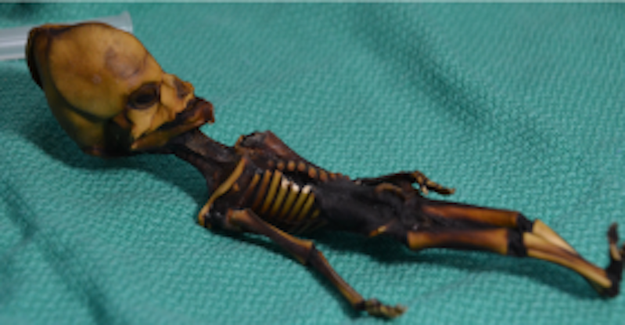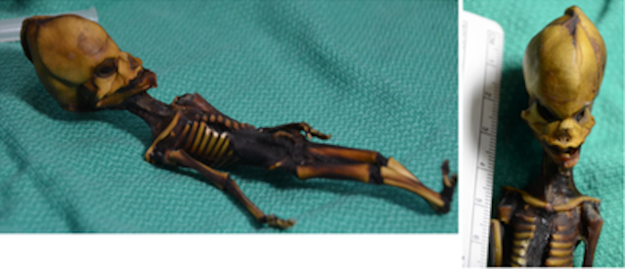 |
| Advertisement |
First discovered in 2003, this tiny skeleton — only six inches long — has been speculated to be a mummified fetus, the remains of a human child with dwarfism, a monkey, or even, ahem, an alien.
The remains of a tiny, mummified, humanlike skeleton were found in Chile about 15 years ago.

The tiny skeleton was discovered in 2003 in a deserted mining town of La Noria in the Atacama region of Chile.
It has a number of abnormalities, including: 10 pairs of ribs instead of 12; a skull defect known as high-head syndrome, where the top of the skull is cone-shaped; and premature closure of the growth plates in the bones, something that doesn't normally happen until a skeleton is much larger, later in childhood.
But this skeleton was only six inches long, which is normally the size of a 20-week-old human fetus.
Bhattacharya S., et al. / Via genome.cshlp.org
People had a lot of thoughts about what it might be.
No one was exactly sure how old it was — or what it was. Researchers thought it might be a monkey, or a human fetus with genetic mutations, or a preterm infant with birth defects, or maybe even a child with a previously unrecognized form of dwarfism.
The so-called Atacama Humanoid was the subject of a 2013 UFO documentary called Sirius, which referred to it as a tiny ET, and discussed "the discovery of an alleged humanoid body whose DNA has been sequenced and found to be of an “unknown classification." You can watch it on YouTube.
A 2013 study determined that it was definitely of human origin, female, and no more than a few decades old.
Now a new analysis of the entire genome provides much more information about the skeleton.

A new study clearly shows that this is a human female with multiple rare mutations in the genes that control bone formation. The research was published in the journal Genome Research, and led by Garry P. Nolan, the Rachford and Carlota A. Harris Professor in the department of microbiology and immunology at Stanford University School of Medicine. Nolan also conducted the 2013 analysis, with colleagues.
"The timeline starts about 50 years ago, which is when we think she died," said study coauthor Dr. Atul Butte, the Priscilla Chan and Mark Zuckerberg Distinguished Professor at the University of California San Francisco School of Medicine.
The DNA sample was somewhat degraded, but not as degraded as truly ancient samples. "This is not like one of those Ice Age samples, it’s more recent," Butte told BuzzFeed News.
An analysis of the mitochondrial DNA, which is inherited only from the mother, suggested she was of Chilean ancestry.
And the DNA mutations are "one-of-a-kind" and "super rare," Butte said. "A whole bunch of these genes are already known to be involved in bone growth and how bones grow and mature and these are new defects, new mutations, that people hadn’t seen before," he said.
The researchers checked for the gene mutations in tens of thousands of known recorded DNA sequences, but didn't find anyone else who had them. "Is there someone else on planet Earth who could have one of these? Could be, you never know until you go look," Butte said.
And it's clear that these are not the remains of a much older child with some type of dwarfism or other genetic changes that stunted growth. "This body, the baby, has a bone-age somewhere between 4 and 6 years of age, but we don’t think that the baby lived that long," said Butte. Instead, the gene mutations were likely causing the bones to age prematurely.
“What we think is probably this baby was still in utero, maybe this was a miscarriage or was not born or was stillborn and had the bone defects that led to the unusual skull and led to the bones growing like this," he said "Or maybe the miscarriage happened because all of these defects."
"It’s a sad story," said Butte. "This is a human girl — there’s a tragedy involved here."
However, the researchers hope the findings can lead to better recognition and understanding of bone growth abnormalities, possibly leading to better treatments for children who have such problems.
Bhattacharya S., et al. / Via genome.cshlp.org
So, you can still believe in aliens — just don't point to this skeleton as evidence that they exist.

"I think this really shows the role in science in puzzling out these interesting questions," said Butte.
The team is "not pursing any other hypothetical aliens," he said, although he thinks “there are still people looking for aliens in the desert of Atacama."
“Look, I love Star Trek, I love all those movies, I watched X-Files," said Butte. "You can still believe — I still believe — but this is not one of them."
Fox / Via giphy.com


0 comments: